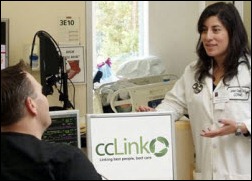Anything related to defense will need to go to Genesis.
News 7/4/12
Speech recognition vendor M*Modal will be acquired by the private equity arm of JP Morgan Chase for $1.1 billion in cash, representing an 8.3% premium over Monday’s closing share price. Philips owned a 70% share of MedQuist until 2008, when it sold its shares to CBay for $200 million. The resulting MedQuist Holdings then acquired bankrupt transcription vendor Spheris in 2010, acquired M*Modal in July 2011 for $130 million, and then took that company’s name in January 2012.
Reader Comments
From HISEsq: “Re: Cerner. Sued for patent infringement by a patent troll named CeeColor, whose only claim to fame seems to be suing HIT and security companies.” CeeColor’s intellectual property, like that of other patent trolls, is vaguely described. In their case, it’s a proximity-based computer security system. I mentioned in March that the same company sued Imprivata claiming similar infringement. Googling their name turns up nothing but lawsuit filings, so one might logically assume all they have is a patent bought elsewhere and a lawyer with lots of free time available to hound companies into paying them “licensing fees.”
From Reppin’: “Re: GSK. You should run the GSK Las Vegas sales kickoff video if you can find it. That’s what’s wrong with healthcare. The big boys scream to government, ‘Get off our backs, we can regulate ourselves.’ They can’t, and a $3 billion fine is nothing to them. Executives should have been fired. They aren’t alone: Abbott, Pfizer, etc.” Drug maker GlaxoSmithKline will pay $3 billion for promoting two of its popular drugs for unapproved uses and for hiding safety information about a third drug. Its marketing tactics included sending doctors on pheasant hunting trips to Europe and paying them for speaking. GSK pushed doctors to prescribe Paxil for depression in children even though the drug was not approved by the FDA for patients under 18. GSK says it has learned its lesson, which would be remarkable given the very long list of similar problems the company has bought its way out of over years (overbilling Medicaid, charging third-world countries high prices for AIDS drugs, adulterating drugs, dodging US taxes, and hiding drug side effects.) Company profits dropped in the most recent quarter to a “disappointing” $2.1 billion, so the “huge” fine amounts to around 18 weeks’ of profit. Maybe that’s the lesson they’ve learned – settlement payouts for arguably criminal wrongdoing are just a marketing cost. If it were me, I’d go after the docs who were willing to place their patients in danger for perks – publishing their names publicly should have been a condition of the settlement. We know drug companies often lean toward scumbaggery given ample opportunity, but they didn’t take the Hippocratic Oath and represent themselves as the patient’s advocate while pimping out their prescription pads.
From Luis: “Re: GSK. Cleveland Clinic is mentioned. Did they find the drug problems with data mining out of Epic?” The original journal article was published by Steven Nissen MD, chairman of cardiovascular medicine at Cleveland Clinic and drug company critic. He did the legwork proving that Vioxx and Avandia cause problems, leading to an FDA crackdown on their use. Above is an interview in which he talks about healthcare reform and how Cleveland Clinic is different. They went live on Epic on the ambulatory side in 2000, so they may well have dug into their own data to link drugs to patient harm. Even if they didn’t, many health systems will be able to do that going forward – all they need is enough patients to make a valid sample size.
From GreenGiant: “Re: Valley Medical Center, Renton, WA. Live on Epic ambulatory on July 2.” I apparently missed the link on their main page. Its board voted in December 2010 to move from McKesson to Epic.
From HIT Guy: “Re: fat-producing foods. The Supreme Court talks about broccoli, healthcare firms punish obese workers, and Vince Ciotti talks about making certain foods expensive. Science is now saying that diets that were previously thought good for you aren’t, and the early studies were good examples of how not to do a study.” A New York Times article talks up a theory that I believe in firmly: weight isn’t as simple as calories in minus calories out, with a new study finding that it’s more about the carbs consumed than the calories. My theory is that weight problems are due to fat storage and insulin regulation (i.e., the hypoglycemic index), not just taking in more calories than are burned off. I also believe that not all exercise is created equal, and pure cardio is good but building muscle is better. You can run your butt off on the treadmill for an hour and only burn the equivalent of a candy bar, so that’s not going to work for most folks unless their body composition changes.
From James: “Re: healthcare system repair. Taiwan was a free market system like ours and became one of the best by going with a single payer, which gets the full pool of money for both healthy and sick patients, can’t cherry pick the young and healthy, negotiates prices with providers and manufacturers, and makes judgments for what to reimburse. Private payers still have a crucial role for all the stuff that the main payer doesn’t cover, like physical therapy, allied health, home care, etc.” I’m frustrated enough with the current non-system here that this alternative is sounding attractive.
From Tom: “Re: healthcare system repair. If I could change one thing, it would be to eliminate employer-based health insurance, a remnant of the World War II era. Individuals buying insurance directly from payers improves continuity of care, removes a major employer cost, incents individuals to manage their health, and reinforces the need for interoperability. It would open the floodgates on HIT innovation and use of tools such as mHealth and PHRs.” I’m becoming cynical that any solution that involves insurance is doomed. Not only because insurance companies will always find ways to make a profit from healthcare, but because healthcare insurance covers more than just catastrophic situations. Homeowner’s insurance is relatively inexpensive because you collect significant amounts only if you suffer major damage, which nobody in their right mind wants, so if we all pay a little everybody is spared from losing their home due to a tornado or fire. Imagine the cost of homeowner’s insurance if it covered every possible problem with appliances, appearance, and the lawn and business were created around collecting inflated payments for providing those services. Not only would policies be priced out of reach, services would become so expensive that you’d have to have insurance to afford them, causing prices to just keep going up to everybody’s benefit except the person needing the service. I’d like to see the concept of healthcare separated completely from the requirement of buying a third-party company’s actuarial bet that you’ll consume less of it than they charge you.
From SW: “Re: ACA. Stan Hupfeld, former president and CEO of Integris Health, wrote an excellent book summarizing the Affordable Care Act, why solutions for other countries won’t or can’t apply here, and how neither party serves us well.”
From CIO: “Re: ROI due diligence on clinical systems. My organization is spending many dozens of millions to install inpatient clinicals. We paid attention to ROI, but it was not the driving factor, and actually I am grateful for that. Proving out a hard ROI is not only a challenge, but I think it diverts attention from the real reasons an organization may want to pursue a new system. Our organization changed our IT strategy after years of integration issues from a ‘best of breed’ to ‘integrated clinical system.’ We did this prior to the guarantee of Meaningful Use funding because we felt it was the right direction for our organization and patient safety. As a part of our new system installations, we resolved a number clinical and IT data exchange issues that have improved patient safety measurably. One small example relates to interface issues with messages erroring out, requiring manual work to resolve the specific problem. On occasion this included patient allergies and other vital data. And for those of you in the industry, you know all the other examples of data exchange challenges that also impacted best of breed approaches. We could have put a price on risk / actual claims / patient harm for this and related issues, but we kept on focus on the improvements we wanted and not the dollars. And frankly with all the other challenges pressing down on hospitals, I take some pride in knowing that we have a safer environment with our new system than our prior ones. This approach may not stand up to real accounting scrutiny, but I think the real question is, ‘Are patients materially safer?’ For us, the answer is yes.”
From Bruce Brandes: “Re: Pliny’s question about FDA regulatory oversight of mobile apps. What Pliny is describing is a clinical decision support system. FDA considers these to be at least Class 1 medical devices per their mobile medical app guidance. Where the data is processed is not important. If the input and display take place on a device, whether it’s a mobile app, web page, terminal application, hardware/software product, then the device is a medical device and subject to regulatory oversight. The determination of whether the device is considered Class 1 or 2 depends on the risk to the patient attributed to a misdiagnosis or delay in treatment. From a regulatory standpoint, class 1 and class 2 devices require the company establish and maintain the same quality management system and design and servicing controls. The only difference is Class 2 devices require premarket approval by FDA, Class 1 devices do not.” Bruce is EVP and chief strategy officer of AirStrip Technologies, which has a lot of experience working within FDA guidelines. I’ve always assumed that most of the healthcare apps out there weren’t created with the FDA in mind, but maybe I’m wrong. Feel free to chime in.
Acquisitions, Funding, Business, and Stock

HealthStream acquires Decision Critical, an Austin, TX-based provider of learning and competency management products for acute care hospitals, for $4.3 million.
Dell will purchase IT management software provider Quest Software for $2.4 billion.
Microsoft announces a $6.2 billion write-down of the $6.3 billion in cash it paid to buy online advertising company aQuantive in May 2007.
Announcements and Implementations
Catskill Regional Medical Center (NY) goes live on Epic in its two hospitals of 235 and 25 beds.
Grand Itasca Clinic and Hospital (MN) announces a partnership with Allina Health System to install Excellian, Allina’s version of Epic. Allina will provide implementation assistance and support.
The local paper highlights the T-System and NextGen implementation of White Mountain Regional Medical Center (AZ).
David Runt, CIO of Contra Costa Health Services (CA), tells me that they went live on Epic (called ccLink at their place) on July 1 enterprise-wide (hospital, clinics, and health plan.) I notice from David’s LinkedIn profile that he spent 22 years as a medical service corps officer in the US Air Force Medical Service, so I’ll throw out an Independence Day nod to David and his fellow veterans for their service.
In the UK, Cerner complains to Cambridge University Hospitals Foundation Trust that its EHR bidding process was a sham and it had already chosen Epic without regard to submitted prices. The trust says it followed the rules when it picked Epic in April.
Oracle announces its Health Sciences Network for developing and conducting clinical trials, working with Aurora Health Care and UPMC to create a cloud-based system to manage de-identified patient information from member providers. Aurora was a key player, providing its patient information in hopes of improving its work in several hundred research studies. Expected challenges include the possible unwillingness of academic medical centers to participate, the difficulty in combining information from a variety of proprietary EHR data formats, and the storage required to eventually add genomic information.
Caradigm, the Microsoft-GE Healthcare joint venture, announces that the number of active users of its identity and access management solutions (Vergence, expreSSO, and Way2Care) has increased by 50% in the past 18 months.
Government and Politics
A proposed California bill would change the Confidentiality of Medical Information Act, which allows patients to sue healthcare providers for up to $1,000 per breached medical record. AB 439 would eliminate damage awards for first offenses and in some cases for repeat offenses if the provider notifies patients whose records were exposed and takes preventive action. The bill’s sponsor is McKesson.
The for-profit technology subsidiary of Palomar Health Foundation, which operates Palomar Pomerado Health (CA), announces that AirStrip Technologies has acquired exclusive rights to its MIAA mobile EMR viewer application. I first wrote about it in February 2011 when Cisco was helping pay for its development.
DataMotion files a provisional patent for a Direct Project-based secure e-mail messaging system for patients and providers.
A London Daily Mail article covers Epic Systems. It’s loaded with snark and off-topic rants, but says that not only will Epic sign a $16 million, two-trust contract, but will soon take on another two hospitals in England and most likely bag more as each trust makes their own decisions and sees the value of using Epic as a data-sharing replacement for the failed NPfIT. It describes Judy Faulkner as “a 68-year-old Harley-Davidson-riding friend of President Barack Obama” who lives in a “nice, but not palatial” house. The paper tried to pry information from someone who answered the phone at Epic and was told, “Your messages have been passed on, and if we want to get back to you, we will.” It speculates that the massive Verona campus expansion was spurred by the likelihood of Epic’s expansion in England.
Another Epic article, this one from Wisconsin, describes the company’s construction boom, with its reporters counting 12 construction cranes hovering overhead. The company expected to hire 300 more employees in June and 1,000 more for the year, bringing its total to over 6,000 (and another 750 expected next year). The Farm Campus will add another 1,000 offices, underground parking for 1,000 cars, and the 11,000-seat auditorium that looks like a UFO crashed and buried itself into cow field. The article says the new construction on the 811-acre campus is valued at around $400 million, with 1,300 construction workers on site making it the biggest construction job in the Midwest.
Orthopedic surgeon Larry Bone MD (I’m not making that up) finishes up basic training and is shipping off to Afghanistan for a three-month tour of duty as a battlefield trauma surgeon. He’s 64. The head of orthopedic surgery at the University of Buffalo wants to give back for the treatment his son received after an IED explosion in Iraq six years ago.
A JAMIA article evaluates CPOE orders that are cancelled and then immediately re-entered on a different patient, concluding that over 5,000 orders per year are being entered on the wrong patient. The proposed solution: make physicians enter the patient ID twice before allowing order entry.
In England, a 22-year-old teaching hospital cancer patient becomes delirious from dehydration and missed meds, finally dialing the equivalent of 911 to say he’s thirsty and nobody will give him water. Nurses send police away when they arrive, but the patient dies shortly afterward. His mother, who says her son was restrained, sedated, and ignored in his room the night before he died, said a nurse asked afterward, “Can I bag him up?”
Sponsor Updates
- Bottomline Technologies offers webinars on payments and cash management.
- RelayHealth shares details of its role in preparing for ICD-10.
- Liaison Healthcare Informatics will provide awareness activities in support of National Health IT Week September 10-15. Liason is also sponsoring NCHICA’s quarterly roundtable meetings for CIOs and CMOs/CMIOs.
Contacts
Mr. H, Inga, Dr. Jayne, Dr. Gregg.
More news: HIStalk Practice, HIStalk Mobile.


![7-3-2012 6-42-48 PM_thumb[1] 7-3-2012 6-42-48 PM_thumb[1]](http://histalk2.com/wp-content/uploads/2012/07/7-3-2012-6-42-48-PM_thumb1_thumb.jpg)








Mr H – have a great 4th! You deserve it.
Was nervous I might not get my HISFix tonight, but thanks to your incredible diligence, at 9:30pm, I got it!
For Bruce Brandes:
Perhaps I can’t parse your sentence, but what EHR products (ARRA certified, at least, with clinical decision support) are not then at least Class 1 devices? And if a distinction isn’t being made about where the decision is being made, doesn’t that mean my ipad-RDP-EHR connection is potentially facing FDA regulation?
I’m sorry if this is a really stupid question, but that’s how I interpret the comment.
Mr. H – is there a reason that we can’t click a link to “see” comments anymore? If I remember correctly, there used to be two links…one where you could click it and the comments would basically display directly below the day’s post w/o reloading the page, and another link that would reload the day’s post only w/ the comments included. I much preferred the ability to just click a link and have the comments appear rather than having to reload the page like what happens now. Sorry to be so anal…I just like to save clicks!
[From Mr. H] That did used to work. I still have the plug-in enabled, but there must have been a conflict when I upgraded WordPress. I’ll look for alternatives.
Re: Taiwan single payer system – “I’m frustrated enough with the current non-system here that this alternative is sounding attractive.”
So it did too to the enlightened who shook their heads in despair and disappointment when the real fix for our non-system here was scrapped before ever starting to discuss what became the ACA.
Finally, I see in writing what I’ve been saying for years. We don’t have healthcare insurance, we have a “payment proxy” situation that masquerades as a discount program masquerading as insurance. Imagine if you asked Jiffy Lube to contact a third party, whom they may or may not have heard of or be familiar with, to negotiate the terms of reimbursement for the oil change you just received. And then, 3 to 12 months later, to send you a bill for the portion that third party has indicated that you owe to Jiffy Lube. How much do you think an oil change would cost if they had to operate that way?
Why have we all come to accept that healthcare has to be that complicated? Nobody would say it’s simple, but we’ve made something (either a human right or a consumer service, depending on your perspective) to complicated for non-industry people to understand. And by promulgating this idea that “healthcare insurance” as currently conceived will solve the problem, we’re digging a deeper hole…
Speaking of insurance, I share your concerns. I went ’round and ’round with the MI Office of Finance and Insurance Regulation. I don’t want my employer’s already expensive insurance offering — it would be less out of my pocket to buy what I need for my family on my own, even when both options are simlar options from BCBS of MI. Too many people don’t think at all about employer-based health insurance and those who do too often think of it as the “benefit” the employer bills it as when it really ought to be evaluated as an expense.
My second comment: I’ve always appreciated and wanted to participate in this, or another similar program (if one exists): http://www.samaritanministries.org/ I like the idea that you get help on the big stuff, but pay for everything else out of pocket. It also takes care of that house insurance argument you presented about appliances and insurance to cover every little thing.
If I could change only one thing about our current healthcare system, it would be to remove the special patent protection for drug companies. Give them the same 7-year patent that everyone else gets. It would reduce costs for consumers and force the drug companies to do develop products faster.